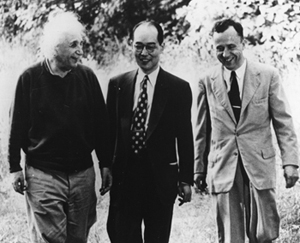
John Wheeler with Hideki Yukawa and Einstein
| HPS 0410 | Einstein for Everyone |
Back to main course page
John
D. Norton
Department of History and Philosophy of Science
University of Pittsburgh
| Black holes are some of the most interesting pathologies in space and time delivered by Einstein's general theory of relativity. They form when matter collapses gravitationally onto itself, such as when massive stars burn out. They are a region of space where the gravitational pull is so strong that nothing--not even light--can escape. Hence John Wheeler called them "black holes." There is more. They incorporate singularities in spacetime structure: points where Einstein's theory breaks down, since the curvature of spacetime becomes infinite. And they can supply bridges to new universes |  John Wheeler with Hideki Yukawa and Einstein |
We tend to associate black holes with Einstein's general theory of relativity. Yet their origins lie firmly in classical, Newtonian physics. They depend on a potentially catastrophic instability that resides merely in the fact that masses attract gravitationally and attract more strongly the closer together they are. So once gravitational collapse starts, its gets harder and harder to stop. This means that fully collapsed bodies that don't allow light to escape are already possible in Newtonian theory.
So far we only have a singular gravitational field. Newton's space and time are unaffected. Now add the idea brought by general relativity that gravity goes with a curvature of spacetime. We find that a singularity in the gravitational field corresponds to a singularity in the structure of space and time itself.
Black holes tend nowadays to be accepted as a routine part of physical theory. That certainly was not always so. Theorists of earlier decades viewed them skeptically. Peter Bergmann, one of Einstein's assistants, remarked that through such singularities, general relativity contains the seeds of its own destruction. As we shall see below, Einstein himself tried to argue (unsuccessfully) that they could not form.
Now we are so confident that there are black holes that the issue is not so much whether they exist, but where we should point our telescopes to see one. They arise either as collapsed stars or as the massive centers of galaxies. The object Cygnus X-1 has long been a strong candidate for a black hole. It is an unseen companion to a visible star that is 33 times as massive as our sun. The star HDE 226868 orbits around a second object so massive and compact that it must be a black hole. That object is Cygnus X-1, a strong candidate for a black hole.
Here is an image of HDE 226868 and its invisible companion taken with an optical telescope at the Palomar Observatory (http://imagine.gsfc.nasa.gov/YBA/cyg-X1-mass/cygX1-image.html)
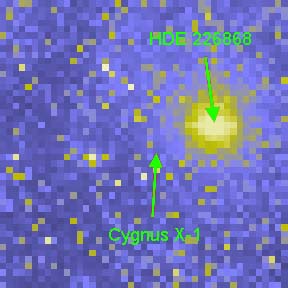
Here's an artist's impression of Cygnus X-1, whose powerful gravity drags matter from its companion star into the black hole accretion disk. (http://agile.gsfc.nasa.gov/docs/objects/binaries/cygx1_artists.html)
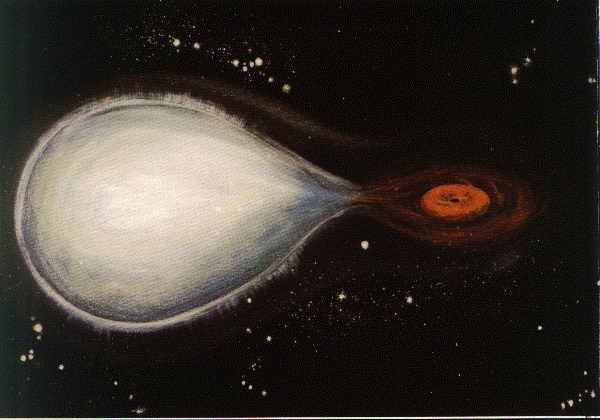
| The process is more dynamic. The two objects orbit each other with a period of 5.6 days as this sped up animation shows (http://heasarc.gsfc.nasa.gov/docs/binary.html). |  |
The images above were drawn from the NASA website, http://www.nasa.gov/, January 21, 2007. NASA provides these images copyright free subject to the restrictions on http://www.simlabs.arc.nasa.gov/copyright_info/copyright.html
The considerations above were the early steps in the identification of black holes. Since then, much has happened. We now know that there are many more black holes scattered throughout space. There is a giant black hole at the center of our galaxy. On September 14, 2015, the LIGO project ("Laser Interferometer Gravitational-Wave Observatory") detected the distinctive "chirp" in gravitational waves emitted by two black holes collapsing together. Their announcement.
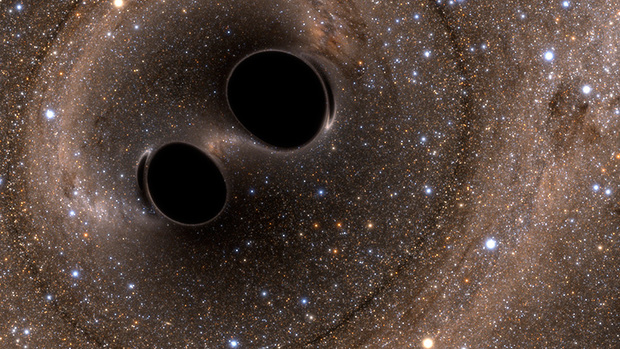
This image is a still from a video simulation of what the coalescence of two black holes would look like. See video.
In April 2017, the Event Horizon Telescope combined signals from several widely spaced X-ray telescopes to produce an image of the black hole at the center of the M87 galaxy, 55 million light years from earth. The black hole is 6.5 billion times as massive as our sun. Here is their famous image. The shadow of the black hole is in the center.
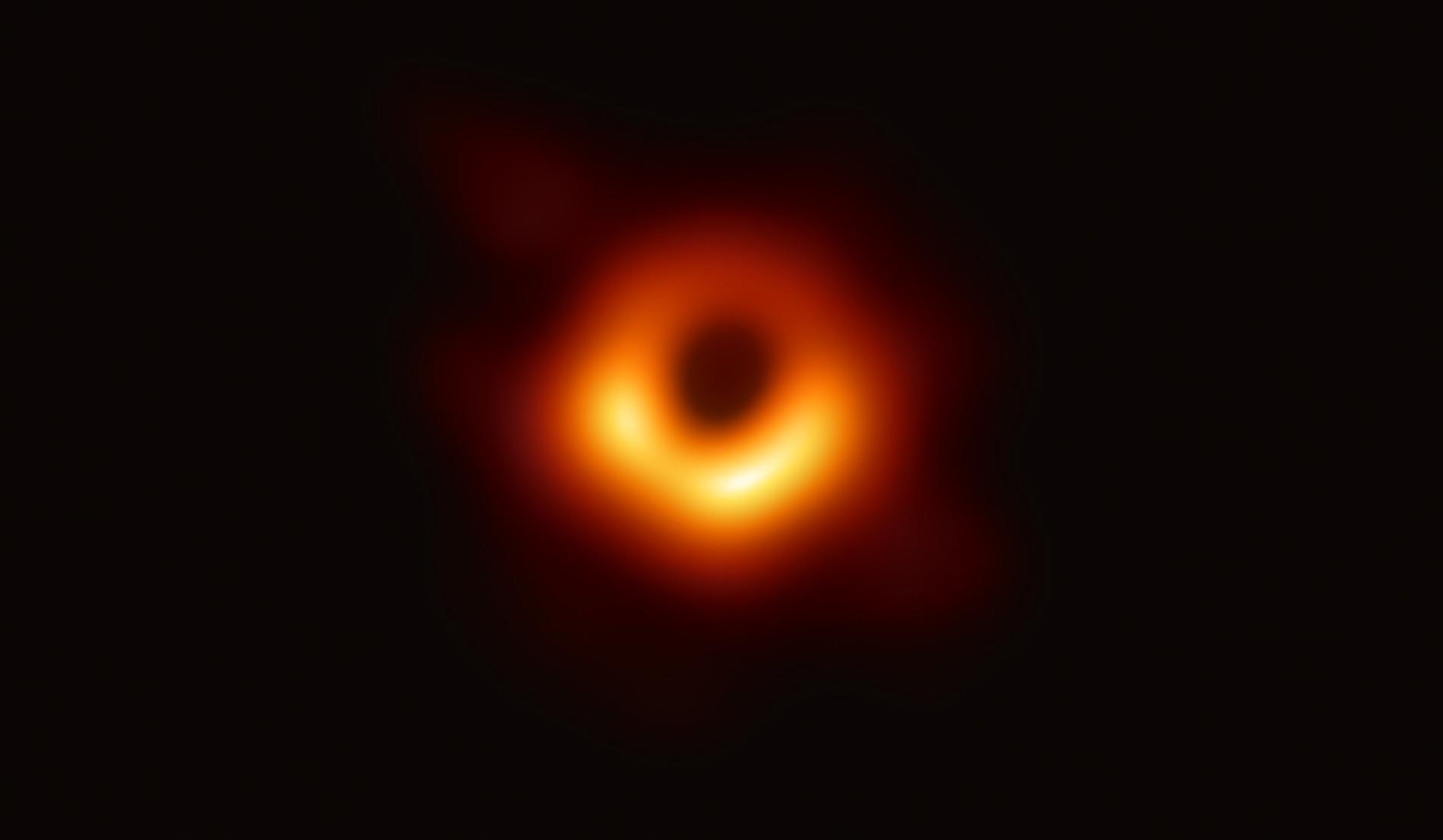
Stable systems are inherently self-correcting. If something disturbs them from their equilibrium state, they naturally correct themselves and return to the equilibrium.
| Consider a heavy office desk. Lift the corner and release it. It falls back to its regular position. It's weight is so positioned that it corrects deflections from the normal position. Things do not spontaneously get hot. If we heat something, it tends to lose heat faster as it gets hotter. Heat a potato in the oven and we can only keep it hot by leaving it in the oven; it spontaneously cools once we take it out. |
An example closer to what is to come is electric charges. They naturally tend to distribute themselves. If we clump a lot of positive charges together, they repel, opposing the clumping. The more we force them together, the stronger the forces of repulsion become. The more they resist.
Unstable systems are not self-correcting under perturbations. They are the opposite. If we disturb them, their natural dynamics magnifies the disturbance.
| Consider a tall, thin bookcase. It is not stable. If we tip it away from its normal upright position sufficiently far, it will fall. Once the center of the weight passes the support, the weight no longer acts to oppose the deflection; it reinforces it. The deflection grows and the greater the deflection, the faster it grows. |
If temperature behaved similarly, our world would be very different. Imagine that, once a body got hot enough, that would somehow trigger it getting yet hotter, and so on indefinitely. We would be standing forever on the abyss of possible runaway processes that yield infinite temperatures.
Now consider gravitational collapse. As Newton first told us over 300 years ago, all bodies gravitationally attract all other bodies. So matter naturally wants to clump together in ever denser, smaller clumps. This process is gravitational collapse.
It is not a self-limiting process. The more matter clumps together, the stronger become the forces that drive the clumping. That is an immediate consequence of Newton's inverse square law. The gravitational force between bodies varies inversely with the square of the distance between them.
As two bodies near and the distance between them reduces from 3 to 2 to 1, the gravitational force pulling them together increases ninefold: from 1/9 to 1/4 to 1.
The same thing happens if we have a large sphere
of matter collapsing gravitationally.
| The figure shows the force on a unit of mass
located at the surface of the sphere. As the size of the sphere
reduces from 3 to 2 to 1, the force on the unit mass at the surface
increases ninefold: 1/9 to 1/4 to 1. For experts only: It is not immediately obvious that this follows from Newton's inverse square law since the force on the mass at the surface will be the total force due to all the other masses in the sphere. These other masses are at many different distances from the unit mass and the forces due to each must be summed. A familiar theorem in Newtonian mechanics tells us that the gravitational force of masses in a sphere on bodies outside it is the same as the force due to a point with equal mass located at the sphere's center. So we can figure out the force on the unit mass by pretending that the masses of the sphere are all located at its center. |
In short, if we have a cluster of masses that fall together under their mutual gravitational attraction, those forces of attraction will grow stronger as the masses come closer together. There is nothing in the properties of gravity to prevent the continued collapse. In this sense, gravitation forever threatens a catastrophic, runaway collapse.
The process of gravitational collapse just described is the process by which stars, galaxies and planets are formed. Cosmic debris, hydrogen or other elements, coalesce under their own gravity to produce these celestial objects. What prevents their collapsing to a point? Other forces intervene.
There are three types of forces that halt continuing collapse. Each force has its limit.
| Gravitational collapse of... | is halted by... | But that halting force can be overcome by... | |
 |
Galaxies and planetary systems. Their matter forms great, orbiting swirls as they collapse together. |
The orbital motion of stars in galaxies and planets in solar systems lead to centrifugal forces that prevent the stars and planets falling to the centers of the systems | If these motions are lost due to collisions, collapse can ensue. |
 |
Stars. They become very hot as they form from gravitationally collapsing clouds of cosmic matter. |
Their high temperatures yield high pressures that balance the continuing pull of gravity. | Stars are radiating away their heat. Even though nuclear reactions contribute more heat, eventually they will burn out and the stars will cool. |
 |
Planets. | The mechanical rigidity of the rocks and incompressibility of the molten core of rocky planets prevent further collapse. The gas pressure of gas giants prevent their collapse. | If the gravitational forces are strong enough because a lot of matter is collapsing, these mechanical forces can be overcome. |
The table summarizes how three different effects prevent complete gravitational collapse. The circumstances with stars needs a little more explanation.
Stars are huge spheres of gases, heated to very high temperatures by the energy released in gravitational collapse and then by thermonuclear reactions ignited by the rising temperatures. Those high temperatures cause the gases to expand. If those expanding gases were somehow trapped in a chamber so the expansion was halted, very high pressures would result. The gravitation of the star itself provides just such a chamber. The gravitational attraction of each part of the star for all other parts pulls back on the other parts, stopping the expansion and producing high pressure.
The stability of the star consists in a perfect balance of the outward pressure forces and the inward gravitational forces. It is a temporary balance, since the nuclear fuel of the stars will eventually burn out.
What makes black holes black is that light cannot escape from them. In this regard, there is a simple analog to the black holes of general relativity in Newtonian physics.
One way to gauge the intensity of the gravitational field of a collapsing body is to determine its "escape velocity." If we have an object on the surface of one of these entities and hurl it straight up, the escape velocity is the minimum speed it would need in a vertical direction to escape the gravitational pull of the entity. On the surface of our earth, that escape velocity is 11 kilometers per second vertically--a quite prodigious speed.
That means that a body hurled directly upward at more than 11 kilometers per second would escape the pull of the earth's gravity with some speed to spare. An object hurled upward at less than 11 kilometers per second would always fall back. The closer the speed gets to 11 kilometers per second, the higher the object would rise before falling back. At 11 kilometers per second, the object has exactly the minimum velocity needed to escape the earth; once it was far away from the earth, all its velocity would be used up by the escape and it would approach rest.
|
Here is what happens when the object
is not given enough vertical speed to escape the earth. |
Here is what happens if the object
is flung more powerfully. |
The idea of being shot out of a canon as a way of escaping our earth has a venerable place in science fiction. It is how Jules Verne imagined that we might take a trip to the moon in an 1865 novel.
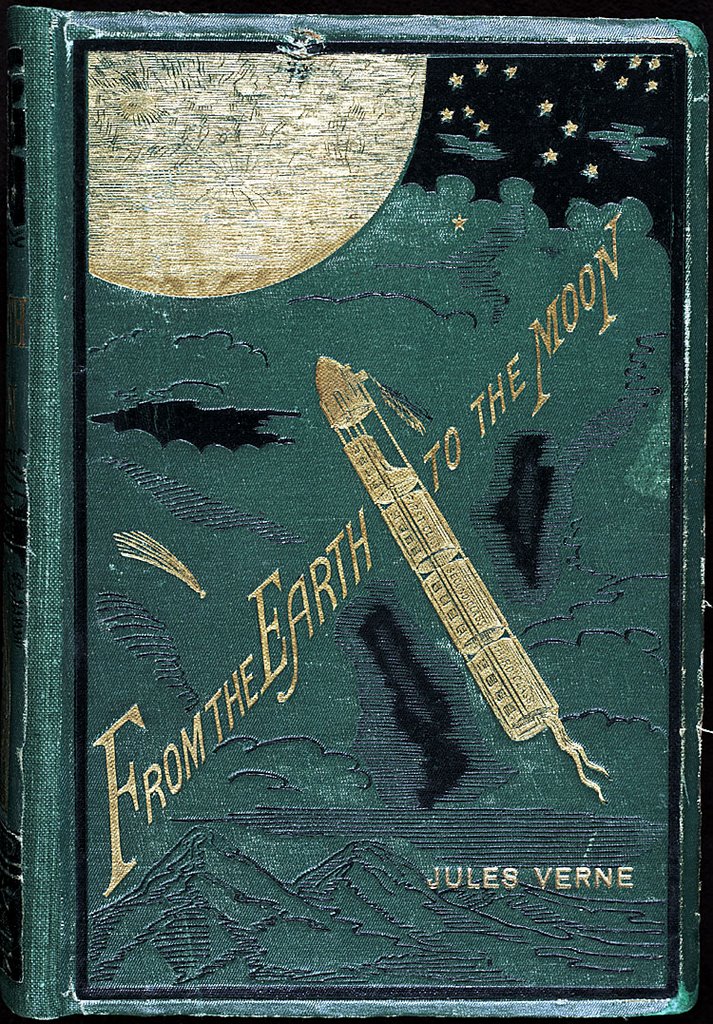 |
 Click here for 7MB animation from George Melies' 1902 movie of Jules Verne's story of a trip to the moon. |
If the earth were to undergo gravitational collapse, that
escape velocity would increase as the collapsing
earth's size decreases. The increase is not as fast as you might
expect. It grows only with the square root of the change in size. The
table illustrates this growing.
| Decrease size by ratio: | Increase escape velocity by ratio: |
| 100 | 10 |
| 10,000 | 100 |
| 1,000,000 | 1,000 |
| So reduce the radius of the earth by a factor of 100 (from 6500 kilometers to 65 kilometers) and the escape velocity increases by a factor of the square root of 100; that is, by a factor of 10. So it becomes 110 kilometers per second. | The precise formula, if you want to
know, is just |
To see the formation of a Newtonian black hole, just continue this collapse process, as in the figure. The Newtonian black hole forms when the collapsing earth's radius passes 1/3". That is an astonishingly small size into which all the matter of the earth must be squeezed. But if it is done, the gravity at the surface is so strong that an object hurled upward at c=300,000 km/sec=186,000 miles/sec could only just escape. Nothing traveling any slower could escape. If the collapse continued to anything smaller than 1/3", then not even objects moving at c could escape.
| The object formed with radius 1/3" from the earth
is a Newtonian black hole. It has many properties in common with the
black holes of general relativity. Most importantly, they both have
the same size.
As the collapse proceeds, energy is released in larger and larger amounts. If the collapse continued to a point, an infinite amount of energy would be released (but would not be carried off by light moving at c!). |
For experts only. The formula for the size rbh
of a Newtonian black hole is easy to compute. The potential energy
of a mass m on the surface of a sphere of mass M and radius rbh
is negative and is just -GMm/rbh, where G is the
universal constant of gravitation. If the mass m moves at speed c
directly upwards, it has kinetic energy (1/2)mc2. If the
mass is just able to escape, these two energies must sum to zero.
Solving we find rbh = 2GM/c2 Curiously, this is the same formula as general relativity gives for the "Schwarschild radius" that designates the event horizon of a general relativistic black hole. |
The existence of the Newtonian black holes and their similarities to the black holes of general relativity is striking. However the significance of their similarities should not be overestimated.
Light cannot escape a Newtonian black hole only if a particular way of escaping is chosen and particular assumptions are made about light: that the light can only escape if it is shot directly upwards like a stone from a catapult and if the maximum speed it has when released from the catapult is c. Newtonian physics would allow things to escape the Newtonian black hole by gentler means. Imagine a rocket ship that fires its motors so as to generate an upward acceleration that is greater than the attraction of gravity. As long as that upward acceleration just exceeds that of gravity, the rocket ship would gently rise and escape. That is not possible, as we shall see, for a black hole in general relativity.
We need not fear that our planet earth will undergo gravitational collapse. The mechanical incompressibility of rock is an enduring feature.
It is not so for stars, such as our sun. The gas pressure that resists collapse depends on the high temperature of the star. Stars radiate and constantly lose the energy that sustains the high temperature. That energy is resupplied by nuclear reactions in the star. When stars form initially from collapsing clouds of hydrogen gas, the hydrogen fuses to form Helium, liberating vast amounts of energy. After that, more fusion reactions occur producing more elements.
These reactions cannot proceed indefinitely. Eventually the nuclear fuel will be spent and the gases will start to cool. When they do, the pressure produced by the high temperature will drop as well. And when that happens, the balance of inward gravitational force and outward pressure will be disrupted in favor of the gravitational forces. The star will begin to collapse in onto itself. The stability of stars is only a temporary circumstance.
What happens next is not so simple. There are many possibilities and astrophysicists have developed detailed histories of how different stars will fare under gravitational collapse.
The most important factor in deciding their fate is the mass of the star. The unit commonly used is "solar mass"--the mass of the star in relation to our sun's mass. "Two solar masses" means twice the mass of our sun. Smaller stars tend to burn out quietly, larger stars are more likely to collapse catastrophically and produce a black hole. The table summarizes some of the major trends.
| Stars of.. | In gravitational collapse... |
| Less than 1.3 solar masses. | Form black dwarves. |
| 2 to 3 solar masses. | Form neutron stars ("pulsars"); or may fragment in supernova explosions. |
| More than three solar masses | Nothing halts gravitational collapse; black holes form. |
While the eventual fate of our sun is clear, we are in no immediate danger. The times required for these processes is of the order of billions of years. Our sun has been gently burning its hydrogen for 4.5 billion years and will continue to do so for another 5 billion.
One might expect that larger stars would live longer since they have more fuel. However the reverse is true. They burn their nuclear fuel even faster so they have shorter lives.
Black holes can form in both Newtonian theory and general relativity. However there are significant differences between them.
| Newtonian black hole | Singular point of infinite matter density and field strength. | Space and time unaffected. | Infinite energy is released in the collapse that forms the black hole. |
| General relativistic black hole | Singularity in spacetime curvature. | Causal structure of space and time affected; there are causally isolated regions of space and time. | Finite energy is released in the collapse that forms the black hole. |
A Newtonian black hole is less radical than a relativistic black hole in so far as the Newtonian black hole involves no disturbance to space and time. Such a disturbance is inevitable in general relativity, since Einstein's gravitational field equations connect matter density and gravitation to spacetime geometry. So if the matter density and gravitational field becomes singular, we should expect similar pathologies in space and time.
A Newtonian black hole, however, is far more radical that a relativistic hole in another sense. In formation, a fully collapsed Newtonian black hole must shed an infinite amout of energy. While we talk of infinities all the time, we should not be casual about such an amount. The release of an infinity of energy in our neighborhood would overwhelm everything. In general relativity, the formation of a black hole does not call for an infinity of energy to be released.
Let us now trace how spacetime is affected by the formation of a black hole in general relativity. The spacetime diagram below shows a sphere of matter undergoing gravitational collapse. It is the simplest case of an uncharged, non-rotating sphere of matter and produces a so-called "Schwarzschild" black hole.
| At the bottom of the figure is a spatial slice of
a fairly ordinary spacetime, in which a sphere of matter begins its
gravitational collapse.
The collapse continues as we proceed up the figure. The sphere becomes smaller and smaller, until it eventually it is so small and dense and its gravity so strong that not even light can escape its surface. That is the formation of a black hole and it happens at a radial position known as the "Schwarzschild radius." For an object the size of the earth, we already saw that radius is 1/3". For an object the size of the sun, it is 2.95 km. (Note that neither the earth nor sun have enough mass to overcome stabilizing forces and produce a black hole.) The radial position from where light can longer escape is called the "event horizon." It is an important boundary in spacetime. Outside the event horizon, rapidly moving bodies that have strayed too close to the black hole can still escape, if they can move fast enough. Once they stray within the event horizon, no escape is possible. The fastest speed relativity theory admits, that of light, is no longer enough to allow escape. Once the collapsing matter has collapsed within the event horizon, the collapse continues all the way to zero size. What results is a point of infinite matter density and therefore a point of infinite spacetime curvature. It is a singularity. Once these two quantities have become infinite, Einstein's gravitational field equations have ceased to function; the theory breaks down. Within the event horizon, all motion of matter and light is towards that singularity. It is everyone's future. In this sense, the directions of space and time are switched within the event horizon. Time now points towards the singularity, for that is everyone's future. |
In a Minkowski spacetime, the light cones mapped out the possible motions and the possibilities for causal connections. In that spacetime, the lightcones were uniformly distributed in spacetime, with no regions of spacetime causally distinct from others. In a black hole, it is otherwise.
| In a black hole spacetime, lightcones far away
from the event horizon are oriented as expected.
As we near the event horizon, the light cones tip over to face the singularity. At the event horizon itself, the light cones have tipped over so far that only motions faster than light can escape falling into the singularity. Within the event horizon, the light cones futures are all pointed towards the singularity. |
A presumption in the literature on black holes is that nothing travels faster than light. We noted earlier that relativity theory does in principle admit faster than light motions--a particle executing them would be a tachyon. However no such particle has been detected.
When we look at these diagrams, it is clear that the event horizon marks a special boundary in spacetime. It marks the point of no return for travelers falling into the black hole. However there is nothing special, locally, at the event horizon that is different from neighboring events. As the traveler passes the event horizon, there are no special flags or markers that the traveler sees. Spacetime around the event horizon will be highly curved but otherwise no different from the spacetime on either side. In brief, the traveler "feels no bump" when the event horizon is passed.
The event horizon gets its special properties from its relation to the global structure of the spacetime and specifically to the singularity and the exterior of the black hole. For it marks the boundary past which a traveler's future must lie in the singularity and can no longer lie in the exterior of the black hole. It is something like the position computed by demographers called the "mean center of the US population." When you stand at that position, which is somewhere in Missouri, the average distance to all peoples in the US comes out to zero. Move an inch to the west and you are now on average closer to people in the west; move an inch to the right and you are now on average closer to people in the east. Of course it is nothing locally about the position in Missouri that gives it this property. It is the relation between that position and all the people spread out over the US.
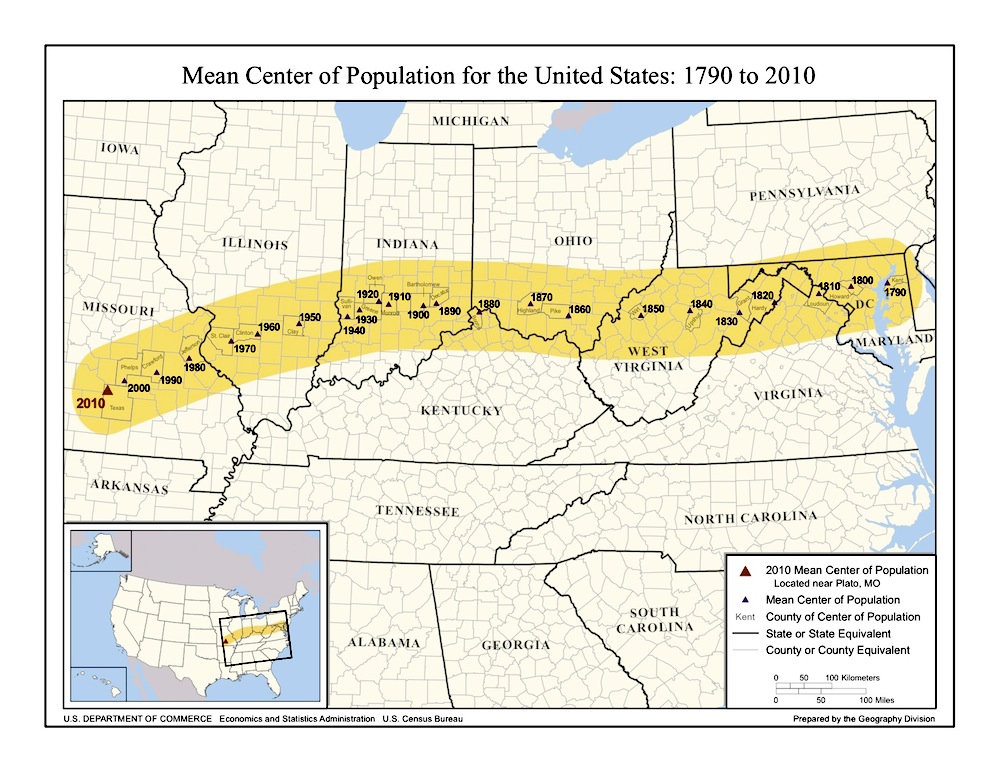
Image source: US Dept of Commerce, US Census,
http://www.census.gov/geo/www/2010census/centerpop2010/centerpop_mean2010.pdf
What would it be like to fall into a black hole? In brief, it would be a mistake one would not want to repeat--although you would not get the chance to repeat it!
The figure shows the worldline of a planet near a black hole and the worldline of a spaceship that imprudently came too close to the black hole and fell in.
The first part of the curve represents that portion of the spaceship's motion that an observer outside the black hole would see. The spaceship would fall rapidly at first towards the black hole. However, as it got closer, it would slow and eventually freeze just outside the event horizon. In the entire lifetime of the outside observer, the body would never actually reach the event horizon. That would be true even if the planet observer lived and observed indefinitely.
All this would be hard to see. Other objects falling into the black hole would be emitting bursts of radiation that would blanket the observer's view. Also, as the spaceship gets closer to the event horizon, light from it would be ever more red shifted and thus weakened and dimmed.
The view of this journey for the spaceship in would be quite different. The outside world appear to speed up and huge amounts of outside time would elapse in the short time the spaceship would take to reach the event horizon. The observer would pass the event horizon feeling no bump in spacetime at all. The final stage of the journey would be completed extremely rapidly as the spaceship reached the singularity.
The diagram is not a good representation of the journey. The spaceship's trajectory is shown in two disconnected parts. It is not a matter that the figure is truncated at the top. If we drew extensions of the figure upward, the two parts of the trajectory would never connect, no matter how big the extension. This is a seriously misleading aspect of the figure. In fact the worldline is a continuous trajectory in spacetime with no break.
The experience for the occupants within the spaceship falling in would be rapid. But it would not be pleasant. The reason is tidal forces.
When we stand on the earth, our feet are slightly closer to the center than our heads. So the gravitational force on our feet is slightly greater than on our heads. These differences of forces are known as tidal forces since they also produce the earth's tides. On earth the effect is so slight that we cannot perceive it.
| If we were to fall feet first into a black hole,
it would be quite different. Once we are close to the black hole,
the gravitational pull at our feet would be very much greater than
at our heads. We would literally be pulled
apart by the difference, as cruelly as if we were placed on
a medieval torture rack that stretched our feet from our heads. In science fiction movies of spaceships falling into black holes, these tidal forces are usually represented as rather interesting optical effects, somewhat like looking at a distorted reflection in a fun house mirror. The voyagers emerge merely ruffled as if they had enjoyed a rather energetic roller coaster ride. In gruesome reality, they would be lucky to be anything other than a bloody pulp. This gruesome end would likely be painless. The time taken between the onset of painful tidal forces and termination in the singularity turns out to be independent of the mass of the black hole. A plausible computation puts it at 0.067 seconds. it is less than the time a pain nerve signal takes to propagate to the brain. The calculation is in Thomas A. Moore, A General Relativity Workbook: Instructor's Solutions Manual. University Science Books, 2013, Problem 19.9, p. 158. I thank Joshua Norton (no relation) for pointing out this calculation. |
These tidal forces may seem familiar. Recall that we gauged
the curvature of space-time sheets by the extent to which free
fallilng bodies converged or diverged. These convergences and divergences
are experienced by the falling bodies as driven by external forces and
they are the tidal forces in question here.
They are called "tidal" because they are
responsible for the ocean tides on earth. Our planet is in free fall
toward the moon. The portion of the ocean's water closer to the moon
experiences a stronger attraction than the portion furthest away. That
elongates the waters that jacket the earth into two lobes. The earth
rotates under these two lobes, once every day, producing two high tides.
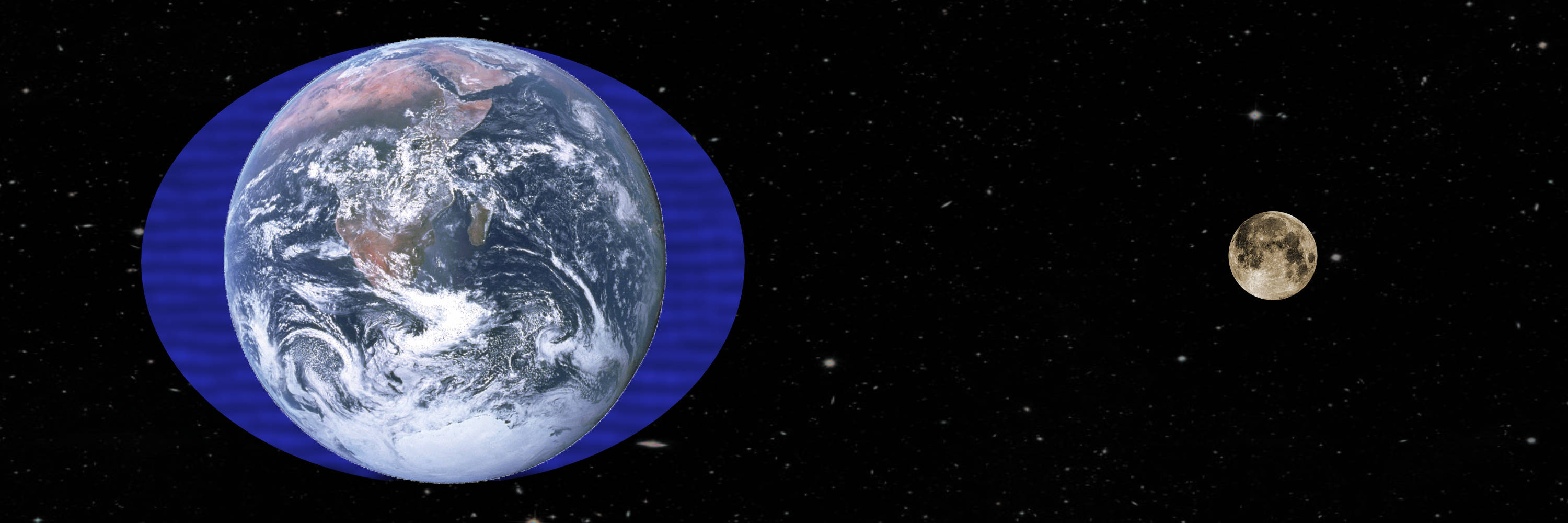
The existence of black holes now seems so familiar that it is hard to imagine that even recently the mere possibility of black holes was seriously doubted. While it seems reasonable to hope that a serviceable theory of quantum gravity might no longer harbor spacetime singularities, present work in general relativity treats spacetime singularities as routine features arising in common spacetimes. The earlier view was that they are pathologies of the theory that could not be realized in nature. We saw a glimpse of this in Eddington's remark that a big bang origin of the universe is "repugnant to me."
| Einstein shared the aversion to black holes. In 1939, he published a paper in which he argued that physical processes would preclude the formation of black holes. His argument was straightforward and not too hard to follow. What is hard to understand is why its conclusion could be seen to preclude the formation of black holes in all generality. | Albert Einstein, "On a Stationary System With Spherical Symmetry Consisting of Many Gravitating Masses," The Annals of Mathematics, 40, (Oct., 1939), pp. 922-936. |
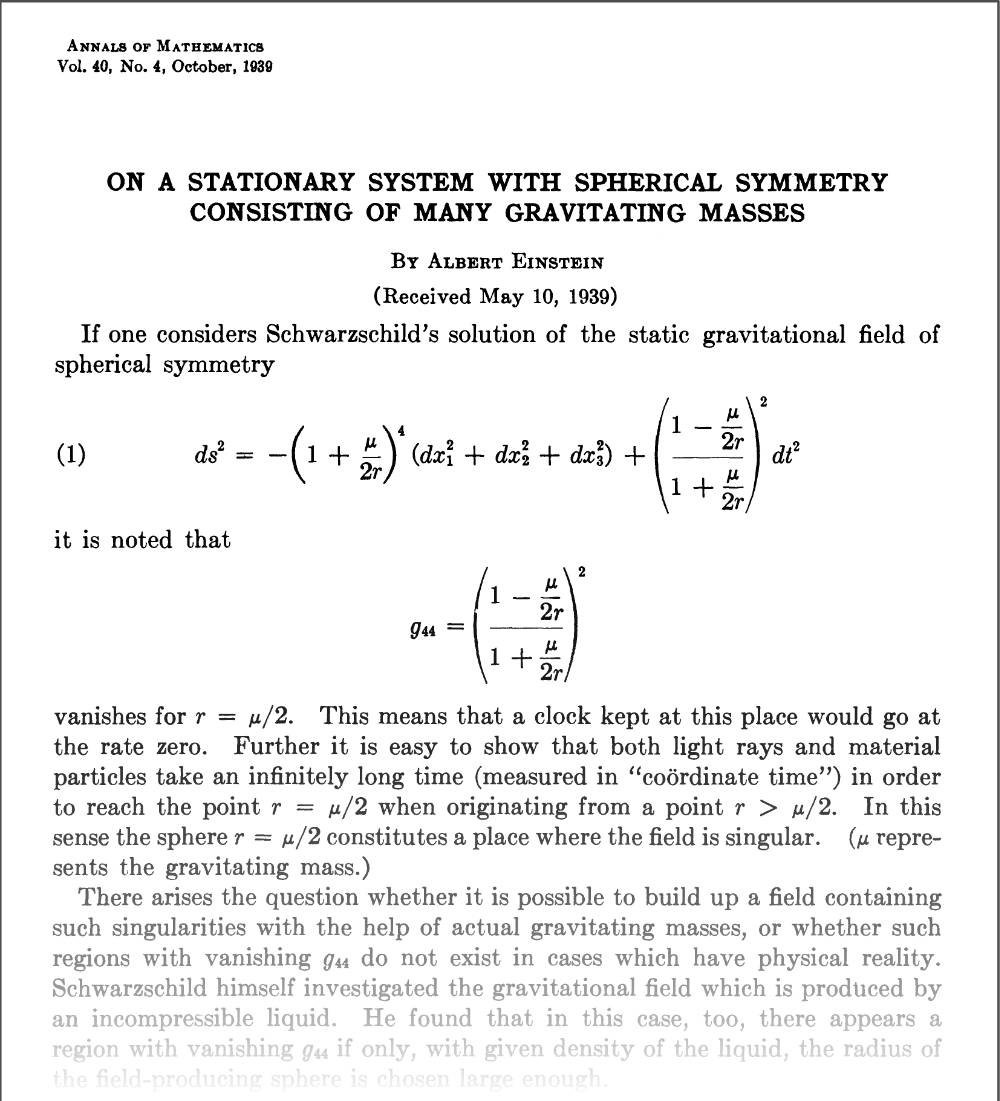
Einstein's argument started by considering a mass in a circular orbit in a Schwarzschild spacetime in a region outside the event horizon. In order to maintain its circular orbit, the mass needs to move very fast. It must do this for the same reason that our planet earth must move quickly in its orbit so that it does not fall into the sun. What Einstein found is that as these orbits get closer to the event horizon, the speed necessary for stability increases until it approaches a limiting orbit that is at a radial coordinate distance r of r = (2+√3) ≈ 3.73 times the coordinate distance rs of the event horizon from the center of the spacetime. The closer the mass' orbit is to this limiting orbit, the closer its speed is to the speed of light. Since, according to relativity theory, ordinary masses cannot move at the speed of light, this limiting orbit is the unrealized limit for the orbital motion of all these masses.
Einstein then considered a swarm of masses all moving in circular orbits above what would be the event horizon. He assumed them to be moving in many directions such that they form a spherical cloud or perhaps a collection of spherical shells around the same central point. Since these masses have a spherically symmetric distribution, they can be source masses for a Schwarzschild spacetime. These masses, if they were to proceed to collapse onto each other, would produce a spacetime with an event horizon that would be inside the innermost shell of the masses, prior to their collapse.
Presumably Einstein imagined cosmic matter collecting under its own gravity and forming the huge swirling configurations that we see in galaxies. As a computational convenience, he added the assumption that their distribution is spherical since then he can conclude that the spacetime structure is that of a Schwarzschild spacetime.
 |
Einstein now argued that his earlier result precludes the masses collapsing and forming an event horizon. He summarized his conclusion as: | The "Schwarzschild singularity" Einstein named here is not the singularity at the center of a black hole. Rather it refers to the event horizon. In the coordinate systems Einstein used to describe the Schwarzschild spacetime, a quantity becomes singular at the event horizon. We now recognize that these singularities are merely artifacts of the particular coordinate systems used by Einstein and not physical pathologies. It remains an open question in history of science why Einstein regarded these coordinate singularities as serious physical pathologies. See below for further discussion. |
"The essential result of this investigation is a clear understanding as to why the "Schwarzschild singularities" do not exist in physical reality. Although the theory given here treats only clusters whose particles move along circular paths it does not seem to be subject to reasonable doubt that more general cases will have analogous results. The "Schwarzschild singularity" does not appear for the reason that matter cannot be concentrated arbitrarily. And this is due to the fact that otherwise the constituting particles would reach the velocity of light."
Einstein's optimism that this mechanism would reappear in any other process is clearly mistaken. We have empirical evidence of that bodies can fall past the event horizons of black holes and merge with the black holes. In January 2020, the LIGO observatory reported finding two cases, ten days apart, of neutron star-black hole mergers. (GW200105, GW200115)
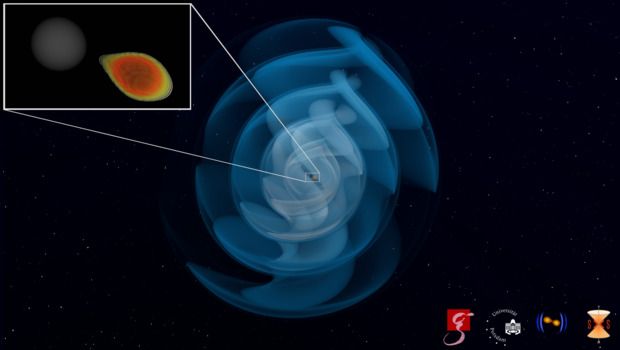
From
the LIGO website, https://www.ligo.caltech.edu/image/ligo20210629d
LIGO image caption: "...image from a simulation consistent with GW200115
GW signal and black hole - neutron star coalescence."
While Einstein's conclusion was clearly hasty, we should not judge him too severely. General relativity does allow these processes of neutron-black hole mergers. However the computations that trace out the details are very difficult and not possible with the simple pen and paper resources used by Einstein in 1939. Present day analyses of these mergers are carried out in massive, computer driven, numerical simulations, such as here.
| There is a deeper reason for Einstein's reluctance to accept the physical possibilities of black holes. He harbored a strong aversion to singularities in his theories. Four years before the paper above, Einstein published a paper with a collaborator, Nathan Rosen. It touched on singularities in general relativity. There they expressed clearly the view that singularities are untenable in a physical theory (p. 73) | Albert Einstein and Nathan Rosen, "The Particle Problem in the General Theory of Relativity," Physical Review, 48 (1935), pp. 73-77. |
"For a singularity brings so much arbitrariness into the theory that it actually nullifies its laws. ... Every field theory, in our opinion, must therefore adhere to the fundamental principle that singularities of the field are to be excluded."
There was a further complication. It is now part of any introduction to black holes that there is nothing pathological in the local spacetime geometry at the event horizon. The point most commonly made is that the spacetime curvature at the event horizon remains finite. It may even be quite small if the event horizon is large, because the mass parameter is large. That, however, was not Einstein's view. He located a singularity at the event horizon, or, as it is sometimes called, the "Schwarzschild radius." In his 1939 paper, Einstein called it the "Schwarzschild singularity." This was the singularity that Einstein and Rosen deplored.
We may now be able to understand why Einstein would deplore ineliminable singularities in spacetime theories, such as the singularity at the center of a black hole. What is harder to understand is why Einstein and Rosen characterized the event horizon as a singularity that should be excluded from physical theories. The reason seems to lie in the particular methods Einstein employed in his theorizing
In this text, the discussion was carried out in what is now called a "geometrical" mode. Structures in spacetime are identified by their geometry: lines, planes, spheres and so on. For example, a circle is presented directly as a figure, much as Euclid would have done.
Einstein however proceeded in an "algebraic" mode. That means that he would describe the figure in terms of variables, like x and y. Einstein's unit circle would have been the formula:
x2 + y2 = 1
Here Einstein is following Descartes' analytic method. His variables x and y are Cartesian coordinates.
It is possible to use many different coordinate systems. We do not have to use the Cartesian coordinates above. A popular choice for a circle are radial coordinates. The radial coordinate r gives the distance of a point from some arbitrarily chosen origin; and the angular coordinate θ determines its direction:
The formula for a unit circle is now:
r = 1
In the end, it does not matter if we treat the circle
geometrically, as did Euclid, or algebraically with either of the formulae
above. The results will be the same.
There is trap for the unwary in using such algebraic formula. Points everywhere in the plane can be identified by giving the unique pair of coordinates r, θ for the point. That is true for all points, except the origin, where r = 0. What value of θ should we assign to it? Since θ is meaningful only in giving the direction in space of a point from the origin, it cannot be applied to the origin. We might assign all values of θ to the origin, or none at all.
As long as we realize that this is the origin of coordinates, we are unlikely to be confused by this problem. If however we just treat r and θ as variables, then we might be very worried that in some circumstances we are unable to assign a value to θ. The remedy is to recognize that there is no problem with the space. This indefiniteness is just an oddity of the coordinate system and not the geometry of the space. A common diagnosis is that the coordinate system "goes bad" at the origin.
Einstein and Rosen's condemnation of the event horizon as singular seems to be tied up with their use of a coordinate system that "goes bad" at the event horizon. They attribute a problem to the spacetime whereas it is merely an eliminable artefact of the particular coordinate system they used. It seems hard to believe now that this was behind Einstein and Rosen's thinking. Perhaps further historical studies will provide a different explanation. For now, however, it seems to be the only possibility.
A spacetime requires four coordinates to identify events. Commonly we have one time coordinate and three space coordinates, such as t, x, y and z. For spacetimes like a Schwarzschild spacetime, it is more convenient to label the events with so called "spherical coordinates." They are a time coordinate t, a radial coordinate r, whose values propagate out equally in all directions from the central spatial point, and two angle coordinates, θ and φ. Using these coordinates, here is how Einstein and Rosen represented the Schwarzschild spacetime in their 1935 paper (for a black hole of mass m in suitable units of mass and setting c=1):
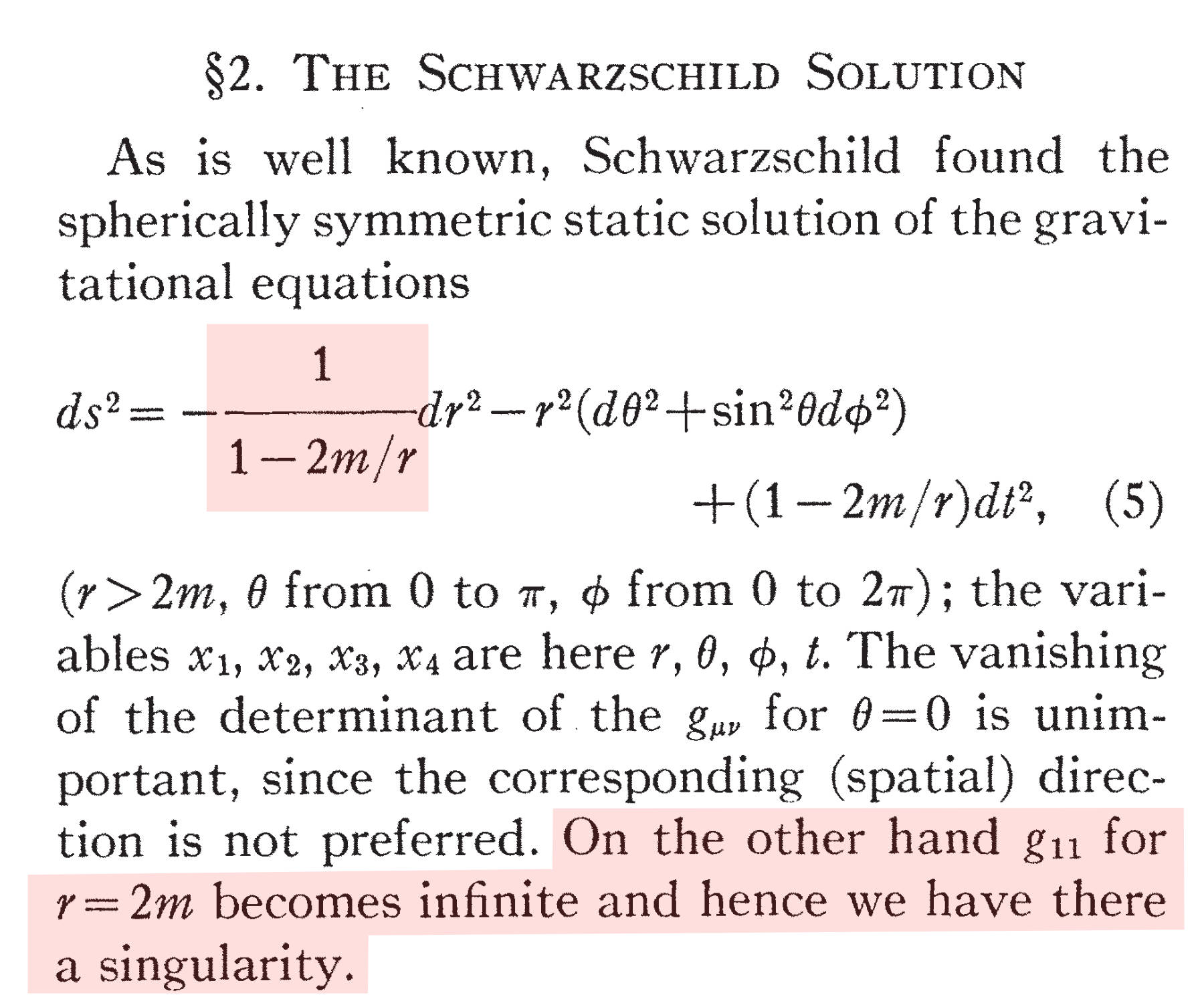
Here is how these coordinates are assigned to events around the event horizon. (The figure does not show the θ coordinate.)
The time coordinate t runs up and down in the figure. The radial coordinate r starts at the event horizon or Schwarzschild radius of r = 2m and proceeds outward. The φ coordinate gives the angular position around the event horizon. These coordinates are not shown within the event horizon since they do not develop continuously past the event horizon.
So far, we cannot see how this coordinate system "goes bad." To that end, we will first suppress further the φ coordinate and just show a two dimensional sheet of spacetime for some fixed φ coordinate value, such as φ = 0. It looks like this:
This appears benign, but only because the figure does not show all the pertinent structure of the Schwarzschild spacetime. It is tempting to imagine that differences in the time coordinate correspond to differences in proper time such as may be read by a clock. That is not the case. Equal differences in the t coordinate in two parts of the spacetime will in general not correspond to two equal increments of proper time.
Consider, for example the equal increments of the time coordinate "dt" shown by the blue marks in the figure:
To find the proper time associated with them, a correction factor must be applied. It is given in Einstein and Rosen's expression for ds2 above. If there is a coordinate difference of dt, then the proper time elapsed is given by:
√(1 - 2m/r) dt
The problem is that the factor √(1 - 2m/r) gets arbitrarily close to zero as the blue marks in the figure approach the Schwarzschild radius at r = 2m; and it is zero at the Schwarzschild radius.
√(1 - 2m/r) → √(1 - 1) = 0
That means that the blue mark at the event horizon corresponds to no difference in time at all. That is, at the event horizon, the t coordinate assigns all values of t to the same event. The coordinate system has "gone bad" in the same way that the radial coordinate system described above went bad at the origin.
There is another problem for small differences in the radial coordinate "dr." The same difference in the radial coordinate r will correspond to different proper distances in space, such as would be measured by a physical ruler. Once again, Einstein and Rosen's formula above supplies the correction factor. The coordinate difference dr must be multiplied by the factor 1 / √(1 - 2m/r) to recover the proper distance. That is, the distance is
1 / √(1 - 2m/r) dr
This factor is the (square root of the) "g11" factor that so concerned Einstein and Rosen in the passage quoted above. Their worry was that this factor 1 / √(1 - 2m/r) takes on an infinite value at the Schwarzschild radius r = 2m:
1 / √(1 - 2m/r) = 1 / √(1 - 1) = 1 / √0 = 1 / 0 = ∞
They were right that this factor takes an infinite value. However that by itself does not establish that there is a pathology in the spacetime itself. As this factor grows larger, the coordinate differential dr, represented by the blue patches in the figure above, can be made smaller at a faster rate, so that the spatial lengths assigned to the blue marks remain finite as the event horizon at r = 2m is approached.
Here is the explicit calculation of this convergence.
In sum, Einstein and Rosen are right to identify a problem in their formula. However they are wrong to identify it as a singularity in the spacetime structure itself. Rather, the odd effects just recounted derive from the unfortunate choice of spacetime coordinates that they have made. As we shall see, with another, more careful choice of spacetime coordinates, these anomalies disappear.
In the case of the circle above, we could describe the same circle in different coordinate systems without changing any of its geometric properties. The same can be done for a Schwarzschild spacetime. We can transform to a new coordinate system in which the pathologies bothering Einstein and Rosen do not appear.
The mathematical details are given here for the curious.
The transformation involves only Einstein and Rosen's t and r coordinates. They are replaced by the new coordinates T and X. The angle coordinates θ and φ are unaffected. When the new coordinate system is explored, we find that Einstein and Rosen's original coordinate system, for the region outside the event horizon, corresponds only to the wedge shown in the figure below:
The upward pointing diagonal corresponds to the event horizon and, crucially, the coordinate system passes through it without any pathologies such as were found in Einstein and Rosen's system. This new coordinate system shows that the region outside the event horizon can be extended through the event horizon to its interior without problems.
A convenient feature of this new coordinate system is that lightlike trajectories once again always propagate along lines at 45 degrees to the perpendicular. This once again makes it easier for us to see which events can affect and be affected by others. These lines are shown here:
We saw above that Einstein and Rosen's t coordinate assigned different values to the same event at the event horizon, r = 2m. If we plot the surfaces of constant t for Einstein and Rosen's coordinate system within the new coordinate system, we do indeed find that they converge to one event at the event horizon.
The figure shows us that this t coordinate does behave like the angle coordinate in our earlier representation of a circle.
Just as the angle coordinate theta "goes bad" at the origin, so also does the t coordinate "go bad" at the event horizon.
Einstein and Rosen's "r" coordinate assigns the same value to events that are the same spatial distance from the event horizon. In the new coordinate system, curves of constant r are now represented by hyperbolas:
As the value of the r coordinate approaches that of the event horizon at r = 2m, the hyperbolas approach arbitrarily closely to the wedge that includes the event horizon. At r = 2m, they coincide with the wedge.